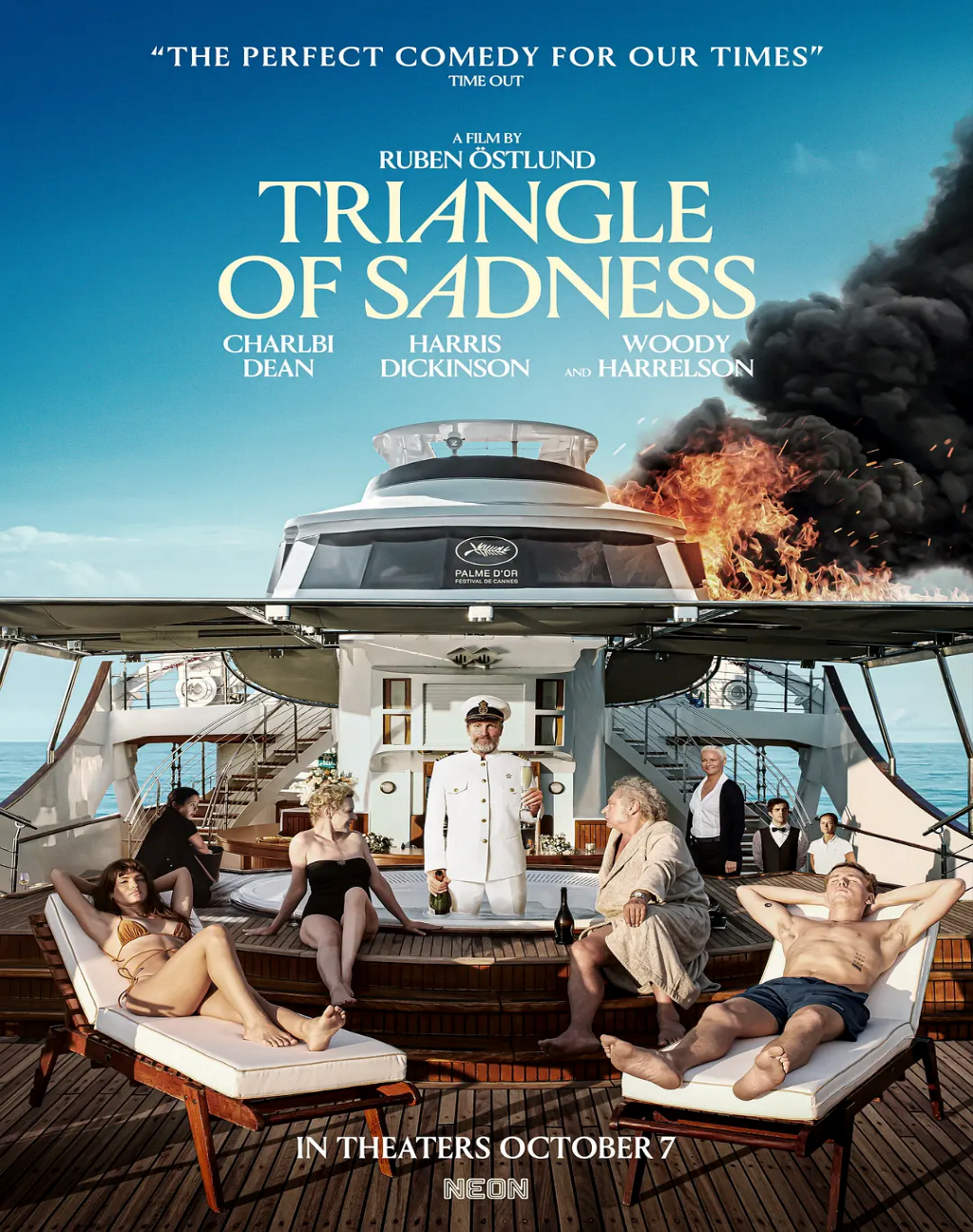In just a decade, Ruben Ostlund has established himself as a new Cannes master and has easily made the progression – with 2011’s “Child’s Play” in the Directors’ Fortnight section, 2014’s “The Tourist” promoted to the Kind of Attention section – and then there was “The Square”, a satirical masterpiece that won the Palme d’Or in 2017. -and then there was 2017’s satirical masterpiece “Squares” that won the Palme d’Or in one fell swoop. This year, he returns with “Triangle of Sorrow,” starring Harris Dickinson, Charlby Dean Crick and Woody Harrelson (translation: Ruben is already among the double Palme d’Or winners for this film). The Swedish director gleefully shared everything with reporters – even the film’s ending – but his film is less about the storyline than it is about the people, and his latest subject – the -the world of fashion, provides plenty of sustenance for his melancholy thoughts.
Q: How does it feel to be back in Cannes? Are you nervous about being in the main competition again?
Ruben: I don’t feel nervous about coming back here, but I was quite tense and even a bit distracted while waiting for the selection notice. I’m very happy and relieved to be selected for the main competition again, and I’m looking forward to showing the film to the audience. What’s special this time is that the restrictions have finally been relaxed quite a bit since the outbreak, so I’m looking forward to the festival where we can all get back to the cinema atmosphere together.
Q: Can you briefly introduce “Triangle of Sorrow”?
Ruben: First of all, I can tell you what the ‘Triangle of Sorrow’ means. If you have a wrinkle between your eyebrows, it’s called “the trouble wrinkle” in Swedish, which means if you have a lot of trouble in your life, you will grow this wrinkle. But you can smooth it out in 15 minutes with just one shot of Botox. It’s a term that comes from cosmetic surgery – not plastic surgery, but cosmetic surgery – and I think it’s hilarious. It’s like a dark and comical commentary on surfaces and beauty – our obsession with beauty, appearance, and our tendency to believe that if we can build a strong shell around ourselves, our inner problems will be solved with it.
Q: This story is about the fashion industry, isn’t it?
Ruben: Yes. And I chose to use the fashion and beauty industry as the backdrop for the new film because of my wife, who we both met around 2014 and who is a fashion photographer. When I met her, I was eager to learn about the fashion world – it has some scary aspects and is fascinating at the same time. She told me a lot about male models, such as the fact that male modeling is not considered a high-status profession; that male models earn a third or less of what female models earn, so it’s a mirror of our society, so to speak, with the roles of the sexes switched. I mean, it’s one of the few professions where men earn less than women. So using that as a starting point, I became interested in the concept of ‘beauty as a currency.
Q: How did the film develop from that?
Ruben: The story first starts in the fashion world, then goes on a luxury yacht, and finally lands on a deserted island – the film basically takes place in these three different scenes.
Q: The film has a strong cast, is there a prominent lead or does it focus on group scenes?
Ruben: I should say there are two main characters. One is Harris Dickinson, who is British and plays a male model in the film. The other is Chalby Dean-Corrick, who is South African and plays a female model in the film. This couple will be the focus of the entire film. But in many ways, it’s also a group movie, because on the yacht and the island, there are about eight actors in the same scene, and we have quite a heavy role for each one of them. We have actors from the Philippines, Germany, France, Sweden, Denmark, the United States and the United Kingdom, so the film is also very international.
Q: Square was criticized for being 150 minutes long, how is the length of this film?
Ruben: It’s not too far off this time. But the story itself took time to lay out, after all we had three main scenes. I want it to be like a mural, so that the audience has a rich experience of an adult version of a roller coaster – because it will be fun, but entirely for adults.
Q: Does that mean there will be adult content?
Ruben: It doesn’t point specifically to that. Maybe some of the content is quite adult, I can’t say too much about that right now, but there are definitely some things that parents don’t want their kids to see.
Q: The film was born entirely in the era of the epidemic, wasn’t it?
Ruben: That’s right. We started working on it in January 2020. There were just the beginnings of the epidemic and it spread quickly to Europe, and the alarm bells went off in my head almost immediately. So we started filming as fast as we could. Because of the embargo, we stopped shooting in March and waited until the fall. In fact, we did shoot a little bit of footage in June: we brought Woody Harrelson to Sweden and tried to get that part done in the window before the embargo. Then we flew to Greece and shot the last part of the film, just in time to kill it the day before another embargo. So it was almost like we were fighting the epidemic while we were shooting the film.
Q: Did you still have to keep your distance from the crowds while you were shooting in Greece?
Ruben: Yes. Greece had some policies – like we couldn’t all board the same boat, that sort of thing. We had 1,160 people tested for nucleic acid at one point, and luckily, everyone was negative, so one positive case and the whole shoot might have gone down the drain and the whole movie would have been postponed indefinitely. Especially when we had to shoot the scenes on the yacht, the rent was not cheap. Of course, there were a lot of interesting things about the shoot and the whole experience was great because everyone worked well together and was able to put aside their differences and work together to solve problems. So, despite all the problems, we had a pretty good shoot.
Q: The world has changed a lot in the last five or six years, has that had any impact on your work?
Ruben: Absolutely. I think “Don’t Look Up” is a great movie, and even though it tries to be (deliberately) satirical, it’s still accurate. These things are happening! But obviously, I’m focusing on a much smaller level. I’m more interested in the social interactions between humans when we have some kind of embarrassment, or dealing with the fear of losing face, etc.
But there are certain parts of the film that do echo the times. For example, on the yacht, Woody Harrelson plays a Marxist captain who takes revenge on the ship’s guests – the wealthy passengers – by deliberately having a dinner party when the weather is bad. All the passengers have to eat a big dinner when the storm comes, and this will turn into a chaos. Only one person did not get seasick, and he was a Russian oligarch. So the communist from the United States and the capitalist from Russia, sat down to drink and started talking politics.
I grew up in the ’80s and ’90s, and the Eastern and Western camps kept pushing their respective ideologies on each other, and by now, all of a sudden this whole Ukraine thing happened, and we seem to be back to this Eastern/Western camp mindset. In many ways, it’s so outdated, but it’s really happening again.
Q: Your 2014 work “The Tourist” was remade by Hollywood as “Everywhere,” did you have anything to do with that film?
Ruben: No, I let go and let them do it. I was happy that they wanted to do a remake and I thought it was important to let them make their own version. I don’t have any objections to that. You can think of it as a play being performed over and over again in the theater – everyone has the opportunity to present their own version. And there are some really good scenes in that movie, and I’m a little jealous of that.
Q: Looking back at The Tourist, can you consider it your breakthrough work?
Ruben: For me, The Tourist was really the first film where I started to look at male behavior – both male figures and male identity in this era. And then “Square” also explores what it means to be a man, what we struggle with, how we are perceived by the outside world? In many ways, you could say that “Triangle of Sorrow” is the finale of this trilogy, and it really explores what it means to be a man. I drew a lot of inspiration from my own life.
Q: Has the film changed your perception of the fashion world?
Ruben: No. I mean, people in fashion are nice, normal people, they’re no different than people in other industries. Once you get to know them, you won’t be shocked by their obsession with clothes. One thing I don’t like about the fashion industry is that it tries to sell us clothing and products by playing on our insecurities.
For example – and it’s shown in the film – if you follow the very luxurious brands, you’ll notice that their models basically never smile and seem to look down on the consumer. It’s like, they’re at the top of the hierarchy, and the clothes are actually sold to disguise yourself in the social group you belong to. So, if you’re throwing money around for those clothes, you can be at the top of the hierarchy and look down on the rest of the people too. On the flip side, the cheaper the brand, the more smiling and welcoming their models are, like, “Maybe we’re all at the bottom of this triangle hierarchy, but we’re going to have a good time together. I would say that the fashion industry knows all about sociology.

